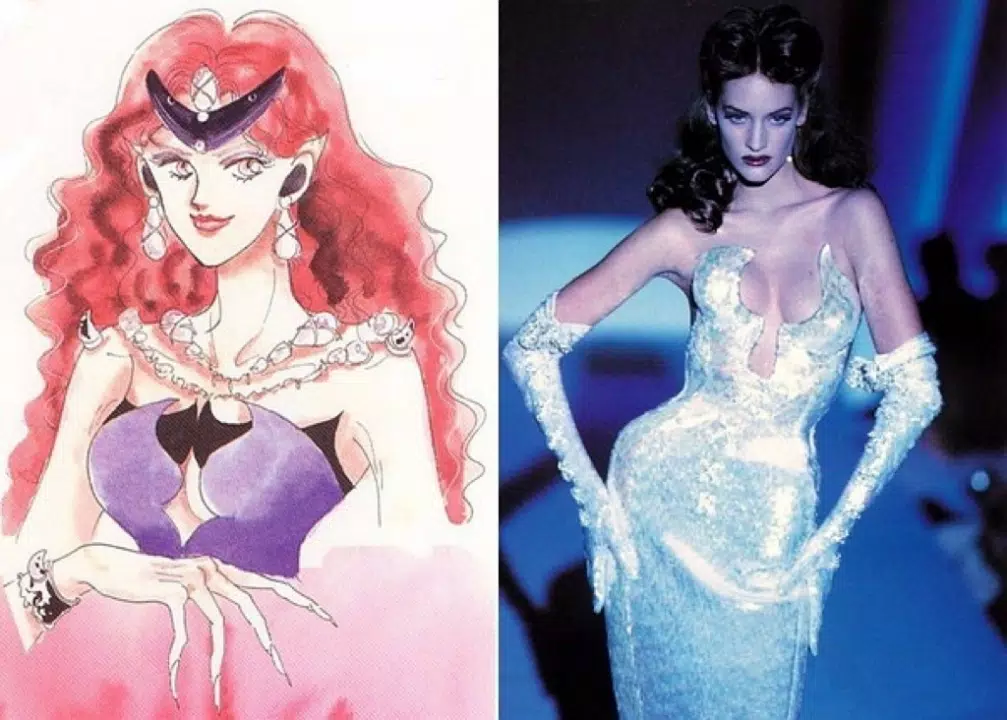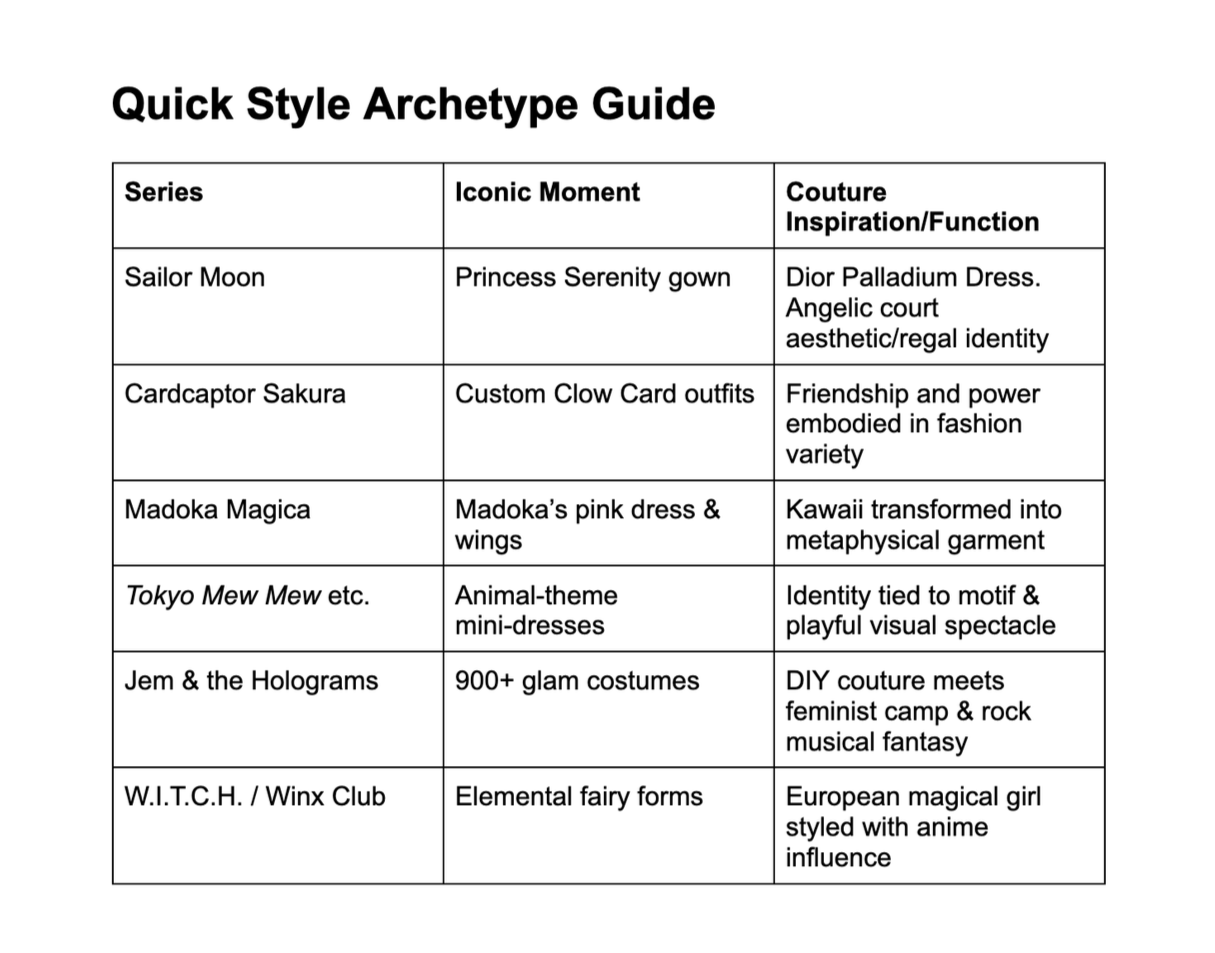Glitter, Wands, and Couture: The Fashion Legacy of Magical Girls in Anime
Hello, my darlings (yes, “my,” you have been promoted)! These past few weeks have been an emotional whirlwind for me; Tiktok has decided to pierce my heart and hit me with a wind of nostalgia that has knocked me off the ground. In case you didn’t know, which wouldn’t be a surprise to me since it is a specific niche, edits of the magical girlies in anime and cartoons that grew us up in the last 60+ years have been trending, especially under the sound of “Honour to Us All” from Mulan (1998). What led to this trend? I am not entirely sure, however I suspect it perfectly aligns with the recent release of a new magical girlies generation called “K-Pop Demon Hunters,” who inspired many editors to change the meaning of the song itself. For those who haven’t watched Mulan, the song is being used to oppress the main character whilst claiming she could only honour her family by getting married, and being a poised, silent and obedient wife. In spite of that, it has now become this beautiful trend that finally gives anime women their greatly deserved recognition, celebrating their integrity and their femininity. So, can you really blame a grown woman for crying?
I am not too sure of the exact time lapse of when I started watching anime, and neither am I sure of what anime was my first, but I am sure of one thing: I started watching male led anime first. Shows like Dragon Ball, Naruto, Bleach, and HunterXHunter were the grounding foundation for my love of the genre. Even at a small age I had great taste. Although, little me felt that I needed something more, shows that had leading characters I could relate to. So, can you imagine how ecstatic I was when Sailor Moon and the endless PreCure series finally made a stop to my TV cable? Exactly. Therefore, I know the feeling a lot of girls, who are now beyond and/or my same age feel while watching those same edits. Gratitude.
Somewhere between a transformation sequence and a cosmic battle lies the true heart of the magical girl genre: fashion that transcends dimensions. Whether it’s a Moon Prism tiara or pastel-powered miniskirt, the magical girl archetype has become a canvas for radical expression, aesthetic fantasy, and more than a sprinkle of rebellion.
Photo: Screenrant
Magical Girls: Born in Japan, Reimagined in the West
It all starts with Sailor Moon—la grande dame of all magical girl wardrobes. Her sailor collar, pleated skirt, and knee-high boots didn’t just reflect Tokyo street style of the '90s. They shaped it. Naoko Takeuchi’s character design introduced a new visual lexicon that merged schoolgirl innocence with warrior glamour. That transformation sequence? Less about modesty, more about metamorphosis.
Photo: Reddit
Other classics like Cardcaptor Sakura, Revolutionary Girl Utena, and Puella Magi Madoka Magica continued this trend. Costumes in these series are intricately tied to emotional development. Frills, ribbons, lace. They symbolize internal power.
Western adaptations followed suit: Totally Spies fused spy gear with Bratz-era glam. Even Star vs. the Forces of Evil toyed with magical girl tropes, pairing unicorns and hearts with grunge-inspired skater dresses.
Photo: Pinterest
When Sailor Moon is awakened to become Princess Serenity, she wears a flowing white gown with an empire waist, gold detailing on the bust and cap sleeves. This design is a deliberate homage to Christian Dior’s Palladium Dress from the Spring/Summer 1992 haute couture collection by Gianfranco Ferré. The gown references Ionic Greek columns: an ancient architectural symbol of nobility and light and it shaped the ethereal elegance of Moon Kingdom royalty in Sailor Moon. It became Serenity's wedding gown in manga and anime form—and forever elevated Sailor Moon’s fashion status to couture legend. Modern creatives still recreate the dress in bridal shoots and cosplay, especially expectant fans who find Serenity’s gown symbolic of maternal grace.
That dress wasn’t remembered. It was immortalized. Fans have tracked it across exhibitions—Tumblr threads even talk about seeing it in person at the Dallas Museum of Art and Brooklyn Museum, calling it “the Princess Serenity reference lol.” And now, these archival inspirations and original designs are on display at the Sailor Moon Museum, showing everything from live-action costume pieces to original manga illustrations and theatrical wedding gowns collaborating with Mariarosa bridal couture.
Photo: Peliplat
Villains in Vogue: Mugler, LaCroix, Chanel in Anime
Takeuchi didn’t stop at heroine fashion. The anime’s antagonists received couture treatment too:
Queen Beryl’s gothic glamour drew from Thierry Mugler’s 1992 haute couture collection, with structured silhouettes, dark sheen, and sharp allure.
Photo: Peliplat
The Ayakashi Sister Karuras wore inspired looks from Christian Lacroix’s Autumn/Winter 1992 and Thierry Mugler Autumn/Winter 1992 Haute Couture: medieval corsetry with metallic opulence, turning dark antagonists into runway-worthy femme fatales.
Photo: Peliplat
Photo: Peliplat
Sailor Pluto wears a garment from Chanel's 1992 Haute Couture Autumn/Winter collections; she also makes an appearance in the third chapter. During the 1992 Chanel show, there were many intricate and ostentatious designs of antique jewellery.
Photo: Peliplat
Modern fashion brands like Samantha Pleet, Lazy Oaf, Anna Sui, and Maison de FLEUR have built entire collections around magical girl energy. Even Jeremy Scott’s Moschino lines have flirted with it—hello, Sailor Moon inspired FW2016!
Western Magical Girl Fashion: Jem and Beyond
While Japan defined magical girl fashion visually, Western cartoons embraced couture through stage spectacle. Jem and the Holograms redefined cartoon fashion: over 900 costumes ranging from glam-rock chrome bodysuits to gender-fluid couture, making it a 1980s fashion icon long before anime crossover culture.
Princess Gwenevere and the Jewel Riders (1995) also merged medieval fantasy with fashion-driven design—armored dresses, metallic bodices, and jewel motifs echoing magical girl tropes in a Western fairy-tale context.
Photo: Wiki
More recent Western efforts like Winx Club and W.I.T.C.H. modernized magical girl wardrobes with trendy color-blocked casual wear and layered fantasy glam, though rarely reaching the couture homage levels of anime originals.
Photo: Reddit
Notable Anime Counterparts & Signature Looks
Cardcaptor Sakura: Sakura’s Minnie-style battle dresses, hand-designed by Tomoyo, showcase fashion as personal agency—with each outfit custom-made, playful, feminine yet functional in magical combat
Puella Magi Madoka Magica: Starts with pink frills and transitions into more complex and darker garb reflecting sacrifice and transformation—her final outfit is emotionally coded and symbolic.
Princess Tutu: Ballet becomes armor. Dancer silhouettes, tulle skirts, and narrative ballet attire embody fairy-tale magical girl energy with emotional stakes on pointe.
While these lack a globally published haute couture artbook like Sailor Moon’s manga, there are archival-quality fan and guidebook materials that celebrate its design ethos—often sold or scanned by collectors and fans.
Conclusion
Magical girl fashion, especially in anime, often catches flak for being “too girly” or “sexualized.” But here’s the thing: the hyperfeminine styling is often a weapon, not a weakness. Characters reclaim pink and glitter as tools of power. The aesthetic dares to suggest that softness doesn’t negate strength. So, if you grew up watching our girls, it’s normal to feel this strong sense of gratitude and pride towards them especially since they have curated a wide range of people to be unapologetic like them.
XOXO, The Fashion Stock Market
Cover Photo: Blogspot
Editor: Annaliese Persaud










